How to design a strategy that is ready for implementation

When you design a strategy your first goal should be to create one that is ready for implementation and execution. Consequently, you must build it in a logical hierarchy, like a chart of accounts for your finances.
More than ever there is a need for building excellence in strategic implementation and bringing strategy to the core of the organization with a structured approach. To ensure that your strategy is ready for implementation and execution, you must create one that is built in a logical hierarchy, similar to a chart of accounts for your finances. The structure enables you to plan logically and monitor progress and results.
Building a hierarchy (a chart of strategic elements) enables you to connect the strategy to the organizational hierarchy: any unit or employee can find out how best to contribute to the strategy by being attached to strategic initiatives and being held accountable. This helps the Executive Team and the board to drive strategic implementation, monitor it, and apply effective Strategy Execution Management (SEM).
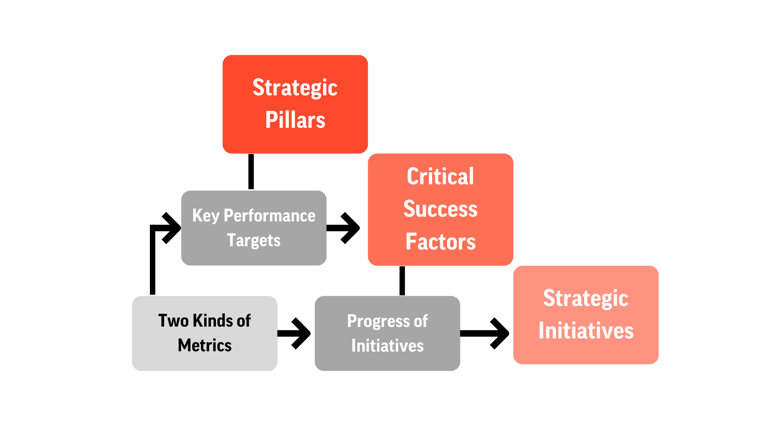
For a more detailed approach, our Strategy Execution Management Guide can help you structure your strategy and keep track of your progress. Implement your strategy in a strategic way by reading this guide written by strategy experts with more than 25 years of experience.
Desired state: where do we want to go?
When you begin a strategic implementation plan, it is essential that you focus on the desired state: a description of where you want to be in a certain period of time. This model is very simple, but effective:
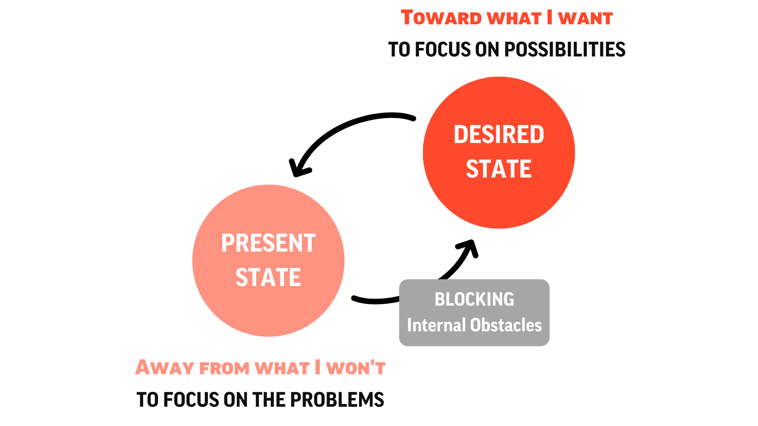
Be careful not to spend too much time talking about the problems you face right now, at the risk of undermining your organization with a negative outlook. This can create delays just when strategic implementation is essential. If just one member of the executive group says, “We’ll never be able to manage that,” doubt will infect everyone’s minds when the team encounters any resistance.
There are a limited number of things our brains can handle simultaneously, and you must be aware of this limitation in your team members. Here is a little example: when we teach this model, we say to our learners, “Don’t think about kangaroos!” What do they all think about? Kangaroos!
It is therefore vital that we focus on the organization’s desired state. We must fill our minds with what the organization needs (mission, vision, strategies, etc.) so that our subconscious can devote its full attention to achieving it. Use swift and clear communication to get this process started as early in the crisis as possible.
Typical characteristics of a Desired State are shown below:
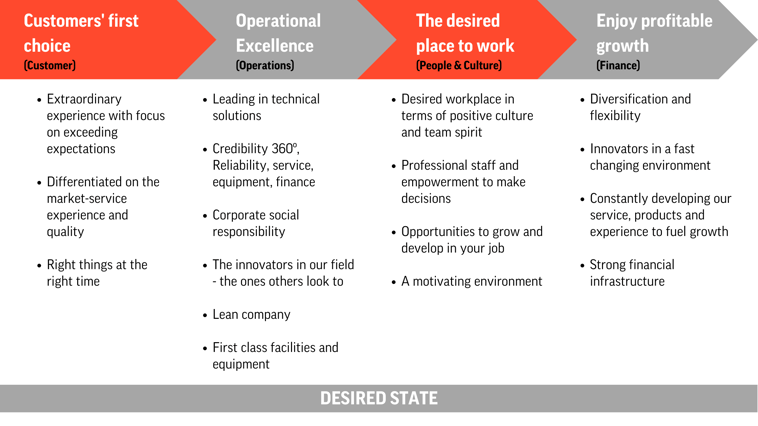
Set up a draft strategic framework
After categorizing and summarizing the team’s views on the Desired State, the next step is to transform it into a draft strategic framework outlining top priorities (Pillars) based on the Desired State. The compilation of the team’s ideas and concerns, summarized clearly, will inspire your team to follow the process through to the end. It will encourage them to overcome whatever barriers they may encounter along the way.
All of the points submitted in the dialogue session for the Desired State are potential strategic objectives. These objectives will fall into categories relating to customers, operations, employees, and finance. The team has automatic buy-in on the process: their ideas and concerns are the foundation for the next steps.
The Hierarchy of Strategic Implementation
To streamline monitoring and follow-up, strategic frameworks are built as a hierarchy. This is a chart of strategic elements similar to the Chart of Accounts in financial accounting. The hierarchy should include:
- Strategic Pillars (three to five areas your organization must excel in to be successful) or Priorities
- Critical Success Factors supporting the Pillars
- Must-Win Battles (to help define strategic initiatives)
- Strategic Key Performance Indicators (KPIs) to monitor the progress of Pillars and Critical Factors.
Using a clear framework helps you make any necessary adjustments to the strategy using real-time data, in an agile culture and with engaged people. A typical framework looks like this:
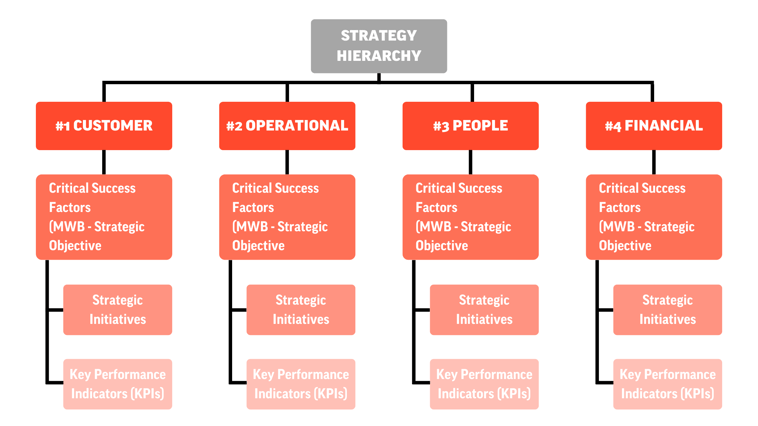
The purpose of this process is Focus and Clarity—to provide a structured overview of what matters most. This should include a thorough analysis of your situation and a roadmap of your organization’s potential while assessing its liquidity, optimization, and profitability. Corporate strategic focus formulated as Strategic Pillars is one of the basic elements of success.
The challenge of keeping the strategy on track
Once you've designed a strategy that's ready to implement, the challenge begins to keep it on track. The problem—given the scale and complexity of modern organizations—is really one of monitoring. Enterprise Resource Planning software today provides CEOs and shareholders with real-time data on the financial underpinnings of a company. They can see everything, from cash flow to inventory levels.
For strategy, matters are much more primitive. Those scribbled notes in a CEO’s notebook are often the only monitoring machinery that exists. The problem is a failure to acknowledge that, as with any other business function, the strategy requires an operational backend to monitor and implement, just as trading or procurement does. Otherwise, matters do not stay on track. Examples of corporate strategies devised at great cost and then failed to be implemented properly are numerous.
Some means to keep strategy on track are structural. It is wise for businesses to establish Strategic Governance Committees to oversee implementation in the same way that another committee might oversee capital expenditure. Likewise, the position of Chief Strategy Officer should be as standard as that of a CFO or COO. As ever with staffing, choosing the right personalities and ensuring that the committee has sufficient power is crucial. Further down the corporate hierarchy, there is merit in reducing or eliminating job descriptions in pursuit of greater agility – that allows individuals to focus on outcomes (benefits) and not on processes.
The role of technology
But there is also a role here for technology. There’s an emerging market for software solutions that provide cloud-based, real-time dashboards for Strategy Execution Management (SEM) for firms of any size. These solutions let business leaders actually transform strategy into action. A simple interface shows progress towards certain defined goals and indicates where problems have occurred. Such platforms are now standard ways to manage many business processes—from logistics to manufacturing—with much greater efficiency. The opportunity here is to have the same gain with strategy.
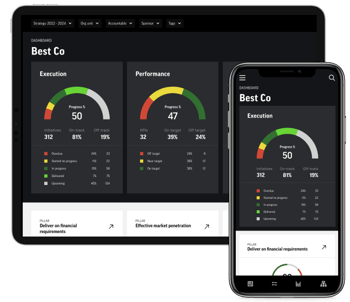
The purpose of SEM is to bring strategic implementation of governance, transparency, and discipline on par with financial management. It cannot be done the old way through notes and spreadsheets. Modern strategy execution requires integrated digital tools; among these is the DecideAct solution.
The introduction of new software tools takes time and effort. Business leaders are understandably sometimes wary of doing so. But, given the striking difference, today in the tools and level of sophistication firms use to manage manufacturing and logistical processes compared with their strategy's strategic implementation, it is time to bring the latter up to speed. We should retire the CEO’s notebook for good.
If you can't afford to lose another strategy in implementation, or if you want to build resilience to withstand the challenges of a changing reality, it’s time to take strategy execution seriously. Make it the core of the organization and implement modern tools to drive execution and follow-ups and deploy an effective strategy.










